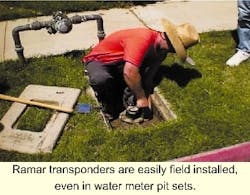Small Utility Implements Phased AMR Deployment
Ed Starner and Jeffrey King
A small utility in Southern California is already accruing benefits from a phased deployment of a new automatic meter reading (AMR) system. The rural retirement community of Hemet, Calif., is deploying Logicon's AMR system for its water system comprised of 9,654 meters.
Until this project was initiated, the utility manually read meters and entered field data using a Logicon handheld computer. Two meter readers handled the entire meter reading operation in addition to their other duties.
Meter reading time averaged about 155 hours per month, which included eight commercial meters in deep vaults requiring California OSHA confined space entry procedures using two crewmen. As in most systems, the workers encountered a host of other difficult-to-read meters which were less costly than the vaults, but nonetheless troublesome.
The Public Works Department researched AMR technology and established its selection criteria. The new AMR had to:
- Be suitable for deployment over several years at the lowest cost.
- Retrofit with all the system's meter types (ABB, Precision, Hersey and Master Meter) as well as the system's encoder electronics.
- Have reception range suitable for drive-by reading of pit installations at speeds of 25-40 mph, and be capable of transition from walk-by to drive-by reading.
- Be compatible with multiple handheld computer meter reading systems.
- Require no FCC licensing requirements.
- Be suitable for pit installations, i.e. reliable without aboveground antennae and impervious to pit flooding due to storms and sprinklers.
- Be suitable for future conversion to a fixed network AMR system.
- Interface with existing billing system.
After researching vendors, Hemet selected the Ramar AMR system with handheld computers and Radio Read software from Logicon because the combination met the performance and cost requirements. The new system consists of radio transponder units wired to the meter electronic encoders for programming ID numbers and initial meter readings. A portable receiver and a handheld computer receive radio reads in the route.
Technical resources from Ramar, Logicon, and meter manufacturers worked together on preliminary deployment issues. Pilot installation points selected included the eight commercial meter vaults. Next, the technicians refined splicing details and sealing techniques, and tested the new system components' water tightness. Finally, after installing a magnetic vehicle antenna in the utility's vehicle, Hemet's newly trained installation crews began deployment in the summer of 1999.
Initial funding from maintenance budgets covered the installation of 154 points spread throughout the town. These points now take only 1.33 hours to read versus the 18 manhours previously required for manual reading. The second phase AMR installation is now underway and includes new installations in a housing development as well as 150 meters scheduled for change-out this year. Capital budget funds are planned for annual phases to change 1000-1600 meters per year to radio read AMR. Hemet is considering switching from bi-monthly to monthly reading and billing for residential customers as the AMR deployment expands.
About the Authors
Ed Starner works for the City of Hemet, Calif. as Public Works Administrative Supervisor, and Jeffrey King is Director of Sales and Marketing at Logicon, Inc. in San Diego, Calif.

